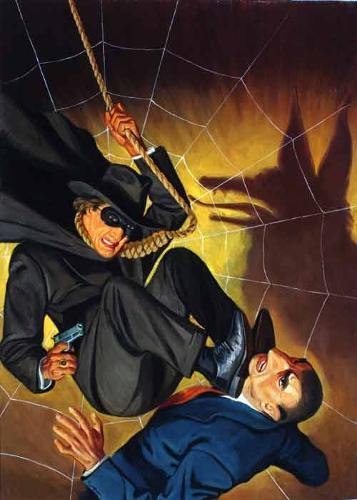Handsome heroes. Damsels in distress. Menacing bad guys.
The 37 paintings at the Mandeville Gallery represent the best of a distinctly American art form – pulp fiction – a form once considered lowly but now gaining in popularity, interest and value.
“Pulp Fiction Paintings: Selections from the Robert Lesser Collection” opens July 28. It features works made as covers for the pulp fiction genre of the 1930’s and 1940’s, which included adventure, mystery, science fiction, war stories and westerns.
Related programming will include two movie marathons at the Nott Memorial – a film noir night, Thursday, Sept. 8, and a science fiction evening, Sept. 22, both from 8 p.m.-1 a.m.
In addition, Janet Casey, professor of English and American Studies at Skidmore College, will give a short talk, “Pulp Fiction and the Modern Reader,” at 7:30 p.m. Thursday, Sept. 15. It will be followed by a reception. The show runs through Sept. 25.
The Robert Lesser Collection of Pulp Fiction Art is on loan from the New Britain Museum of American Art in Connecticut, to which it is also a promised gift. The paintings, by 12 artists, were done as covers for magazines and so-called dime novels. They were developed specifically for a male audience during the Great Depression and World Wars.
“The subject is escapism, pure and simple,” said Marie Costello, Mandeville Gallery interim director, noting that stereotypes and exaggerations are rampant, with sex, crime and violence the main themes.
“At the time, these paintings were not regarded as works of art. They were commercial art, a quick way to make money in hard times. Only over time did they become valued.”
Lesser, a Manhattan businessman, began collecting pulp paintings, comic books and comic-character toys in the 1950s while growing up in Chicago and New York. His father, a salesman, had been a devoted reader of the classic Argosy, the first pulp magazine, which dates to 1888. The publications were printed on cheap newsprint, hence the term pulp.
As a student at the University of Chicago, Lesser studied literature and continued his fascination with popular culture. In 1972, while working on his book, “A Celebration of Comic Art and Memorabilia,” he was approached by an art dealer to buy a painting of “the Shadow,” the 1930s radio-serial crime fighter who famously knew “what evil lurks in the hearts of men.” The painting showed the sinister-looking, black-clad figure clawing a net in which he’d been captured. It was made for the cover of the September 1933 pulp magazine The Shadow.
After his purchase, Lesser “began to realize, my God… these little ten-cent pulps had magnificent oil paintings for the cover art. I was amazed at how great some of it was, how well-trained these artists were.”
Lesser, who is also the author of the 1997 book, “Pulp Art: Original Cover Paintings for the Great American Pulp Magazines,” has estimated that some 50,000 pulp paintings were produced, of which fewer than 1,000 survive. He owns 200 of them.
“He loves America,” Costello said, “and he believes these pieces are uniquely American.”
